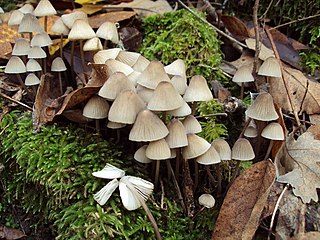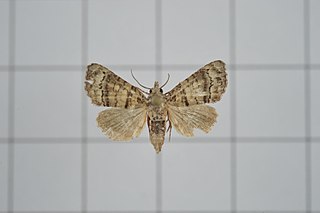
A mushroom, or toadstool, is the fleshy, spore-bearing fruiting body of a fungus, typically produced above ground on soil or on its food source.

Flies are insects with a pair of functional wings for flight and a pair of vestigial hindwings called halteres for balance. They are classified as an order called Diptera, that name being derived from the Greek δι- di- "two", and πτερόν pteron "wings". The order Diptera is divided into two suborders, with about 110 families divided between them; the families contain an estimated 1,000,000 species, including the familiar housefly, horse-fly, crane fly, and hoverfly; although only about 125,000 species have a species description published. The earliest fly fossils found so far are from the Triassic, about 240 million years ago; phylogenetic analysis suggests that flies originated in the Permian, about 260 million years ago.

The fungal order Agaricales, also known as gilled mushrooms or euagarics, contains some of the most familiar types of mushrooms. The order has 33 extant families, 413 genera, and over 13000 described species, along with six extinct genera known only from the fossil record. They range from the ubiquitous common mushroom to the deadly destroying angel and the hallucinogenic fly agaric to the bioluminescent jack-o-lantern mushroom.

Psilocybe cyanescens is a species of potent psychedelic mushroom. The main compounds responsible for its psychedelic effects are psilocybin and psilocin. It belongs to the family Hymenogastraceae. A formal description of the species was published by Elsie Wakefield in 1946 in the Transactions of the British Mycological Society, based on a specimen she had recently collected at Kew Gardens. She had begun collecting the species as early as 1910. The mushroom is not generally regarded as being physically dangerous to adults. Since all the psychoactive compounds in P. cyanescens are water-soluble, the fruiting bodies can be rendered non-psychoactive through parboiling, allowing their culinary use. However, since most people find them overly bitter and they are too small to have great nutritive value, this is not frequently done.

Paul Edward Stamets is an American mycologist, author and advocate of bioremediation and medicinal fungi.
Fungiculture is the cultivation of mushrooms and other fungi. By growing fungi, food, medicine, construction materials and other products can be attained. A mushroom farm is in the business of growing fungi.

A sclerotium, plural sclerotia, is a compact mass of hardened fungal mycelium containing food reserves. One role of sclerotia is to survive environmental extremes. In some higher fungi such as ergot, sclerotia become detached and remain dormant until favorable growth conditions return. Sclerotia initially were mistaken for individual organisms and described as separate species until Louis René Tulasne proved in 1853 that sclerotia are only a stage in the life cycle of some fungi. Further investigation showed that this stage appears in many fungi belonging to many diverse groups. Sclerotia are important in the understanding of the life cycle and reproduction of fungi, as a food source, as medicine, and in agricultural blight management.

The Sciaridae are a family of flies, commonly known as dark-winged fungus gnats. Commonly found in moist environments, they are known to be a pest of mushroom farms and are commonly found in household plant pots. This is one of the least studied of the large Diptera families, probably due to the small size of these insects and the difficulty in specific identification.

David Arora is an American mycologist, naturalist, and writer. He is the author of two popular books on mushroom identification, Mushrooms Demystified and All That the Rain Promises and More....

Mycena galopus, commonly known as the milking bonnet or the milk-drop mycena, is an inedible species of fungus in the family Mycenaceae of the order Agaricales. It produces small mushrooms that have grayish-brown, bell-shaped, radially-grooved caps up to 2.5 cm (1 in) wide. The gills are whitish to gray, widely spaced, and squarely attached to the stem. The slender stems are up to 8 cm (3 in) long, and pale gray at the top, becoming almost black at the hairy base. The stem will ooze a whitish latex if it is injured or broken. The variety nigra has a dark gray cap, while the variety candida is white. All varieties of the mushroom occur during summer and autumn on leaf litter in coniferous and deciduous woodland.

The fly Megaselia scalaris is a member of the order Diptera and the family Phoridae, and it is widely distributed in warm regions of the world. The family members are commonly known as the "humpbacked fly", the "coffin fly", and the "scuttle fly". The name "scuttle fly" derives from the jerky, short bursts of running, characteristic to the adult fly. The name "coffin fly" is due to their being found in coffins, digging six feet deep in order to reach buried corpses. It is one of the more common species found within the family Phoridae; more than 370 species have been identified within North America.

Phylloporus rhodoxanthus, commonly known as the gilled bolete, is a species of fungus in the Boletaceae family. As suggested by its common name, the distinctive feature of this species is its yellow gills—an unusual feature on a bolete mushroom.

Russula densifolia, commonly known as the crowded russula or the reddening russula, is a species of agaric fungus in the family Russulaceae. It was first described in 1833 and given its current name in 1876. A widespread species, it is found in Asia, Europe, and North America, where it fruits on the ground in mixed and deciduous forests. Fruit bodies (mushrooms) are robust and squat, with caps up to 14.5 cm (5.7 in) in diameter, and stems that are 2–7.5 cm (0.8–3.0 in) long by 1.2–2.5 cm (0.5–1.0 in) thick. The mushrooms are characterized by the red and then black color changes that occur in the flesh when it is bruised, and a relatively thick cap cuticle. Although the mushroom is sold as an edible species in some areas of Asia, it is mild to moderately toxic, and may cause gastrointestinal upset if consumed. Several bioactive compounds have been isolated and identified from the mushroom.
Megaselia rufipes, the coffin fly, is a species of scuttle flies.

Chlumetia transversa, the mango shoot borer, is a moth of the family Noctuidae. The species was first described by Francis Walker in 1863. It is a widely distributed across Indo-Australian tropical countries far east to Solomon Islands.
Drosophila neotestacea is a member of the Testacea species group of Drosophila. Testacea species are specialist fruit flies that breed on the fruiting bodies of mushrooms. These flies will choose to breed on psychoactive mushrooms such as the Fly Agaric Amanita muscaria. Drosophila neotestacea can be found in temperate regions of North America, ranging from the north eastern United States to western Canada.
Spiroplasma poulsonii are bacteria of the genus Spiroplasma that are commonly endosymbionts of flies. These bacteria live in the hemolymph of the flies, where they can act as reproductive manipulators or defensive symbionts.
Megaselia halterata is a species of scuttle fly or hump-backed flies in the family Phoridae. "The mushroom phorid" is also used to refer to M. halterata. Megaselia halterata is a common pest of mushroom cultivation, attracted by the aroma of developing fungal mycelium. The larvae damage both the mushroom mycelium and gill tissues. Megaslia halterata can be found worldwide.
Howardula is a genus of nematode that infests the larvae of mushroom-feeding flies. Various Howardula species and strains infest mushroom-feeding Drosophila, including Howardula aoronymphium and Howardula neocosmis. Howardula husseyi can infest the mushroom phorid Megaselia halterata.














